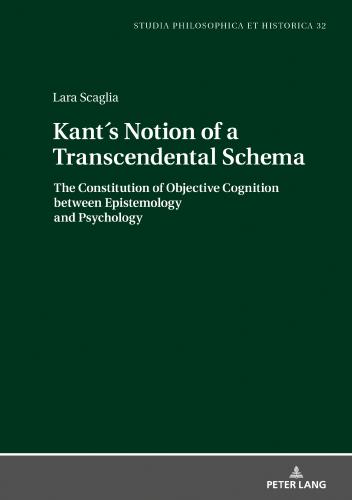c)Difficulties within Kant’s text
Part II: After Kant
1. The philosophical reception and criticism of the schematism chapter
1.1The earliest receptions of Kant’s schematism chapter
1.2Idealism and post-Kantianism
1.3From the late nineteenth to the early twentieth century
2. Kant’s distinction between philosophy and psychology
2.1Philosophy as a system of concepts
2.2Psychology: a doctrine of the inner sense
2.3Is Kant a transcendental psychologist?
3. Kant’s notion of a schema in twentieth-century psychology
3.1Schema theories
3.2Frederic Bartlett
3.2.1A pioneer of applied psychology
3.2.2Experimental method
3.2.3The topics of experiments
3.2.4Remembering
3.2.5Schematic settings
3.2.6Meaning
3.2.7Conclusion
3.3Jean Piaget’s interpretation of Kant’s notion of a schema
3.3.1An interest in both theoretical and empirical studies
3.3.2A “philosophical shock”
3.3.3Piaget’s notion of schemata
3.3.4An example of a schema: the object
3.3.5Experience as an organisation through schemata. Piaget’s perspective between empiricism and apriorism
3.3.6Piaget’s novelty and difference from Kant’s view
3.4Lawrence Barsalou’s reception of Kant’s transcendental schematism
3.4.1Cognitive psychology
3.4.2Categorisation
3.4.3Modal theory versus amodal theory
3.4.4Properties
a)Neural representations
b)Schematic perceptual symbols
c)Multimodal symbols
d)Simulators
e)Frames
f)Linguistic indexing and control
3.4.5Barsalou and Kant
3.4.6Psychology and philosophy
Conclusion
Schema: the history of an idea
The function of schematism
Schematisms’s legacy between philosophy and psychology
New perspectives
Bibliography
Lists of abbreviations for classical works
Primary literature
Secondary literature
Online resources
List of figures
List of tables
Index
The main aim of this book is to provide a critical and historical inquiry on Kant’s schematism chapter contained in the Critique of Pure Reason. More specifically, I am going to argue that Kant’s schematism chapter is a necessary step within the project of the Critique. It deals with a problem of its own, one which is not the object of the previous chapters: how can categories be applied to intuitions? I will show that the term ‘schema’ has an interesting and long tradition of different philosophical uses that finds in the works of Kant a point of no-return. In the philosophical works written before Kant, the notion of schema did not have a specific and distinctive meaning and function of its own but was rather used in different contexts (from rhetoric to logic to psychology). After Kant, all philosophers who speak of schemata refer in one way or another back to Kant’s distinctive notion, which possesses a specific, epistemic meaning. Moreover, I aim to provide a contribution to the understanding of the relation between philosophy and the sciences. I will do this by means of demonstrating the importance of the schematism chapter, not only within the Critique, but also from a broader perspective, deriving from the fact that Kant’s doctrine of schemata had an impressive influence not only on philosophers, but also on psychologists.
The project originates from the results obtained through my Master’s thesis about Kant’s notion of experience and the task Kant ascribes to philosophy, namely to deal with the conditions of possibility of experience and of sciences, limiting their domains. Particular disciplines sometimes use and find their claims on the basis of hidden assumptions (for instance through a definition of justice or of goodness) that, although at their basis, are not openly scrutinised. For example: physicists do not ask themselves what the meaning of expressions such as, “to make a discovery” or “atoms exist” is, or what the relation of the existence attributed to atoms and the existence of complex objects of everyday life is. Such problems are regarded exactly as the main aim of philosophy from a critical perspective: to clarify concepts for the purpose of checking or defending our epistemic judgements. A critical, philosophical attitude characterises those researchers who, when confronted with something puzzling (for example: the oar, which appears to be bent when held under the water, but is straight when held outside of it), rather than rejecting the problem, they try to analyse and ←15 | 16→clarify its underlying assumptions. In this example, the conflict between different kinds of perceptions remains (the oar held under the water and the oar outside of it; the sun that rises, although we know it does not actually do so), but the unity of experience is saved: there are not two worlds in opposition to each other (the “world where the sun rises” and the “world of physical theories”), because our apparently opposing claims are not absolute but have to be seen as standing within a field of reference, a framework of conditions of possibilities, which philosophy aims to bring to light.
From this standpoint, I have decided to devote my attention to Kant’s notion of schema, which has often been regarded as the most obscure topic of the Critique: “famous for its profound darkness, because nobody has ever been able to make anything out of it” (Schopenhauer 1819, p. 552, transl. R. B. Haldane & J. Kemp). In a similar way, Hegel refers to Kant’s artificial “[…] construction through lifeless schema” -“[…] Construction zum leblosen Schema” (Hegel 1968-, 7, p. 36, transl. L.S.) - and Herder regards ‘schema’ as “[…] a fictitious middle term between two vanished fictitious functions.” - “[…] dritte Fiktion zwischen zwei verschwundenen Fiktionen.” - (Herder 1799, p. 418, transl. L.S.). While many critics reject its importance and suggest that Kant’s schematism chapter is a redundant part of the Critique of Pure Reason, I believe that it is productive to apply the principle of charity in order to figure out the function Kant attributes to it. Most importantly, of the problem the schematism chapter aims at solving is this: what is the method of application of pure concepts to intuitions? It is one thing to possess a concept, or to know a rule; it is quite another thing to apply the concept and to recognise
